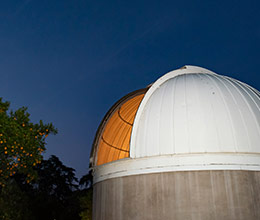How is the Sun's Outer atmosphere heated to millions of Degrees?
Find out more about how the sun effects daily life on earth.
Give to Physics and Astronomy

The Department of Physics and Astronomy has a solar observatory, stellar observatory and planetarium, and faculty and students study exoplanets and the formation of new planets and stars. CSUN researchers also make use of the new 4-meter Daniel K. Inouye Solar Telescope (DKIST) located in Hawaii and the Dunn Solar Telescope located in Sunspot, New Mexico to study solar activity and magnetism. With the campus’ San Fernando Observatory (SFO), they measure the Sun’s total brightness. Several astrophysicists are involved with the theory and observations of planets and planet formation as well as the search for new planets using adaptive optics techniques applied to direct imaging.
The DKIST helps researchers understand how energy moves within the Sun, its explosive behavior and observe its magnetic fields. These are all topics that CSUN physics and astronomy scientists have been investigating since the 1960s! The DKIST’s 4-meter mirror provides views of the solar atmosphere that have never been seen before. Focused on observing small changes, the DKIST’s instrument suite is capable of gathering unprecedented images of the Sun-- from its surface to the lower solar atmosphere. It can reveal features nearly four times smaller (down to 20 km.) than anything seen on the Sun today, and does so multiple times a second.
Moved from a former site and newly dedicated on campus in 2016, the SFO monitors the Sun’s activity and is used by students and faculty alike. Understanding the Sun’s small-scale magnetic activity will help scientists predict solar flares. These large bursts of particles and energy can have devastating effects on Earth’s technology, and predicting their occurrence and behavior is a major goal for modern solar physicists.